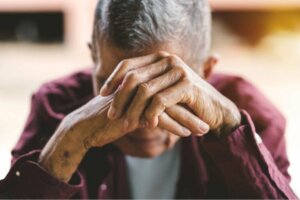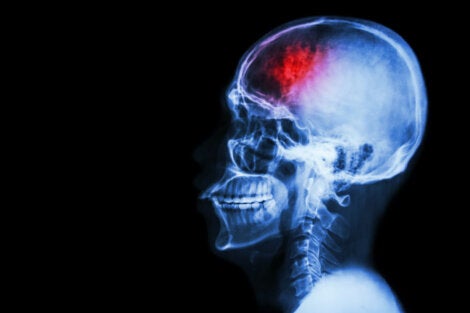Emotional and Behavioral Changes Brought on By a Stroke

The effects of a stroke can be very serious, and the degree of disability ranges from moderate to serious. However, there are other side effects that people don’t think about as much but are equally important. If they aren’t addressed, they can become debilitating. We’re talking about emotional and behavioral changes that patients sometimes experience after a stroke.
Post-stroke neuro-rehabilitation focuses more on restoring a patient’s motor skills. A stroke can cause hemiplegia, difficulty walking, aphasia, cognitive decline, etc. These side effects are the most common in a broad list of potential problems, and they require a lot of attention. However, if the patient doesn’t get help for their emotional and behavioral changes, their physical rehabilitation might not progress as expected.

What’s a stroke?
A stroke is a sudden interruption or reduction in blood supply to the brain. It causes a combination of physical symptoms and cognitive changes that can be temporary or permanent.
Strokes affect 13 million people worldwide, and hundreds of thousands suffer functional limitations that result from a stroke. Stroke incidence is increasing. However, it’s important to note that 90% of strokes are preventable.
In Spain, stroke is the second leading cause of death. For women, it’s the number one cause of death. It’s also the number one cause of disability in adults and 35% of stroke victims are of working age. That may be surprising for most people because stroke is considered something that only affects the elderly.
As we mentioned above, there’s a broad range of potential side effects, and some can be very serious. Most people who suffer from a stroke will suffer psychopathologies that arise from the perception of the loss of functional abilities. These changes can actually end up being more debilitating than the physical side effects of the stroke.
The most common types of emotional changes
- Pathological emotionality or pathological laughter or crying. This is when a patient laughs or cries in a disproportionate way to the stimulus that triggers the said reaction.
- Emotional incontinence. This is related to the previous point, as it refers to difficulty regulating and expressing emotions. The emotional response can be disproportionate or inappropriate in terms of frequency, intensity, and duration. They can also be completely out of context.
- Post-stroke fatigue. Intense exhaustion from any minimal mental or physical effort. It can be accompanied by a subjective sensation of exhaustion. Some people also have trouble starting tasks that require any kind of effort, as minimal as it might be.
- Catastrophic reactions. An individual with this condition might also have other symptoms of depression.
- Apathy. A loss of interest in things, people, and activities.
- Anosognosia. A lack of awareness of the illness. The most noticeable thing about this particular symptom is the emotional indifference to the disability.
- Irritability and aggressiveness. This is very common. It can be verbal or physical (towards objects and people).
- Anxiety or depression. These are very common after any kind of brain injury. A stroke, however, always involves some kind of functional loss or loss of ability. That means that patients have to experience the grieving process, which can cause depression and anxiety independent of the injury itself.
These symptoms vary from one person to the next, and they can be difficult to diagnose. Nevertheless, the medical system should have adequate procedures in place to ensure timely detection and intervention for stroke patients.
Secondary behavioral changes after a stroke
- Changes in social behavior. This is the most common alteration and can encompass all the rest. Those close to the patient tend to observe that they aren’t the same. They notice changes in character, personality, the way they treat others, etc.
- Infantilism. The tendency to act irresponsible and naive.
- Inflexibility. This is another of the main symptoms. It refers to the inability to change already set plans. A reduction or deficiency in working memory can cause this symptom.
- Selfishness. Stroke patients are often egocentric and unable to put themselves in other people’s shoes.
Adaptive social behaviors require understanding other people’s points of view. This ability is called theory of mind. The lack or reduction of this ability means that you can’t understand the people around you or their needs. This obviously causes a lot of problems in relationships with others.

The importance of addressing these changes
As you can see, the emotional and behavioral changes are natural reactions to the stroke. However, they can have negative consequences for a patient’s recovery. A good attitude and motivation are crucial for success in the rehab process. It’ll be much faster and more positive if the patient is cooperative and willing to do what’s necessary.
With that in mind, the patient should ideally go through neuropsychological rehabilitation, as well as neurological rehabilitation. The patients and their close family members should also get psychological attention to ensure that these emotional and behavioral changes aren’t an obstacle to recovery.
To conclude, it’s also important to be aware of the patients’ family or primary caregivers’ emotional state. Caring for a stroke patient can be overwhelming and often affects caregivers’ psychological health. Making sure that they’re healthy and have the resources they need is crucial for their own well-being and for the well-being of the stroke patient. After all, there’s no better way to care for others than to care for yourself. As the saying goes, you can’t pour from an empty cup.
This text is provided for informational purposes only and does not replace consultation with a professional. If in doubt, consult your specialist.








